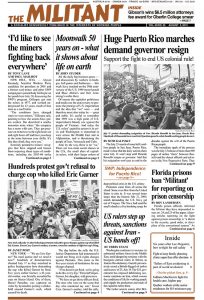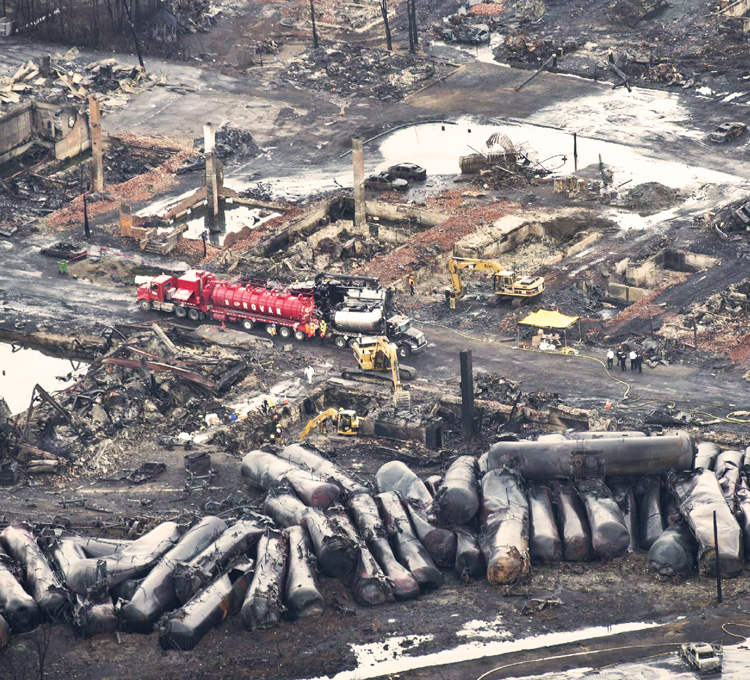It has been six years since a driverless 72-car oil train rolled into downtown Lac-Megantic in Quebec at 65 mph, derailed and exploded, killing 47 people and leveling the city’s downtown on July 6, 2013. But the conditions facing rail workers, and those living near rail tracks, remain as dangerous as ever, as profit-driven rail bosses press for longer trains at faster speeds with smaller crews.
“Not much has changed since that night in Lac-Megantic,” wrote New York Times correspondent Ian Austen July 16 after visiting the area. “The core of the town remains a wasteland, with much of the once-vibrant downtown a weed lot.”
But the rail tracks were the first things rebuilt downtown and put back in operation, as area bosses depend upon them to profit off shipments to and from the town’s factories. While the tracks are six years older, maintenance “remains largely unchanged from the time of the disaster,” wrote the Times.
While there was much handwringing by authorities after the disaster, ongoing derailments and deaths — in both Canada and the U.S. — have continued. And 62 “runaway” trains in Canada took off on their own in 2017.
Lac-Megantic residents have demanded a rail bypass around the town be constructed for trains carrying hazardous materials, but the federal and Quebec governments have been slow to act. They finally agreed last year to fund such a project, but its completion date is four years away.
After Lac-Megantic, the national regulatory agency Transport Canada ordered rail bosses to review their train routes to see if dangerous goods could be rerouted around urban areas. When the Times reporter asked the two main Canadian railroads — Canadian Pacific and Canadian National — what they had changed, they refused to answer, referring the paper to the Railway Association of Canada, their lobbying group. The association also refused to answer, citing supposed “security purposes.”
The U.S. Federal Railroad Administration told the Times such cargo is rarely rerouted because “alternatives may increase overall transit time” — i.e., cut profits.
‘Blame the workers’
The rail bosses and Canadian government tried to blame the Lac-Megantic disaster on the workers. But the only “crew” on the train was engineer Tom Harding. To cut costs, the bosses had gotten special dispensation from the government to operate with a one-person crew running on 12-hour shifts.
In accord with company procedures, Harding had kept the lead engine running to engage the air brakes when he left the train for the night and also set hand brakes to prevent the train from rolling downhill. During the night, firefighters, who had been called to put out a small fire — caused by company neglect of maintenance — shut down the engine, which let the air brakes bleed out. Without air brakes the train rolled into Lac-Megantic and exploded.
After a three-month trial last year, a jury found Harding, train traffic controller Richard Labrie, both members of United Steelworkers Local 1976, and Jean Demaitre, a low-level former manager of now defunct Montreal, Maine and Atlantic Railway, “not guilty” on all counts in the deaths of 47 people.
“This verdict is a victory for workers,” Gilbert Carette, a member of the Citizens and Groups Coalition for Rail Safety in Lac-Megantic that has been fighting for a rail bypass, told the Militant after the trial. “This tragedy, caused by company negligence and government deregulation of the rail industry, was placed on the shoulders of innocent workers.”
“One man crew should never exist,” Montreal rail worker J.C., who asked that his full name not be used, said to the Militant. The government should not be “giving the free reins to a private company to organize and evaluate safety.”
There has been an increase in derailments, injuries and deaths of rail workers on North American railroads as the bosses push for more work assignments at a faster pace with less crew and inadequate track maintenance. This new operating scheme designed to boost profits is called “precision scheduled railroading.” The system — first used in Canada and now spreading to most major railroads in the U.S. — centers on squeezing shippers to have loaded cars ready faster, assembling trains that contain 200-plus cars by one-person crews using a remote control, and fighting to reduce operating crews to one.
Over 1,300 derailments in 2018
There were more than 1,300 train derailments in the U.S. last year and 230 so far this year, according to the Federal Railroad Administration.
“Not knowing at what time we will work makes operations dangerous,” Philippe Bourdon-Tremblay, a five-year rail worker in Quebec, told the Militant. “The same bosses who work 9 to 5 demand that we be on call 24 hours, 365 days a year, with most of the time only two hours’ notice to be on the job. The maintenance of equipment by the bosses is minimal, because investing in safety for employees isn’t profitable.”
Three rail workers were killed in February when a mile-long Canadian Pacific train with drained air brakes and 112 loaded grain hoppers rolled down a steep grade in British Columbia. In June a Union Pacific freight train carrying bombs and other military munitions derailed near Elko, Nevada.
And rail bosses are pushing to run even longer and heavier trains. Earlier this year a 278-car coal train — 2 1/2 miles long — was sent as a “test” from a Powder River Basin mine in Wyoming to a power plant in Wisconsin.
“We should fight for no trains over 50 cars in length, with four-person crews — with two engineers on the locomotive and two on the rear of the train,” said Joe Swanson, a retired rail worker with 31 years’ experience, who recently ran as Socialist Workers Party candidate for mayor of Lincoln, Nebraska. “For a safe workplace we must use union power and fight for workers control.”


